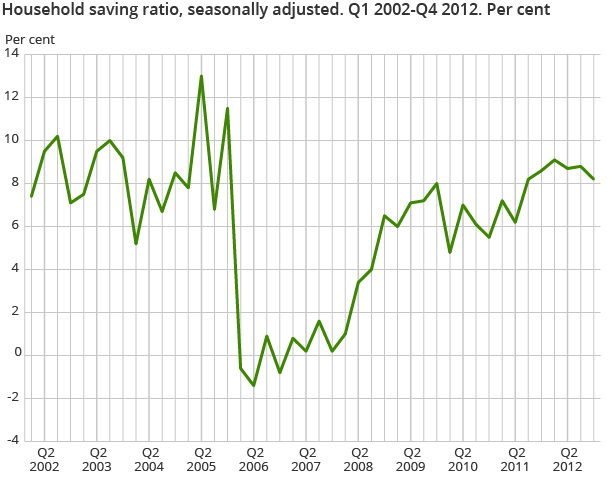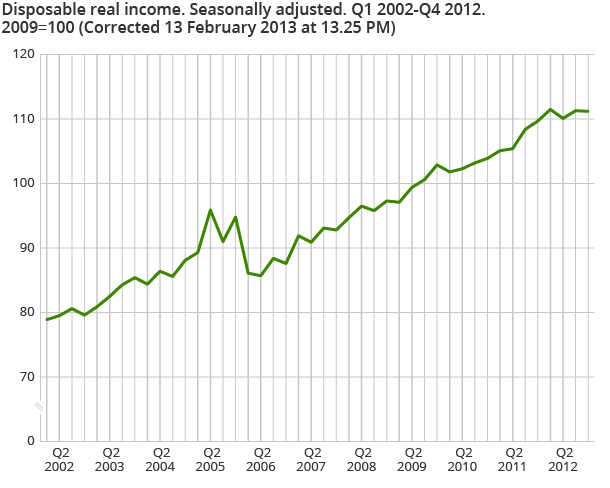Content
Published:
This is an archived release.
High household saving
Household disposable income increased nominally by 0.2 per cent from the 3rd to 4th quarter of 2012, according to seasonally-adjusted figures. For the full year of 2012, the increase was 4.9 per cent. Since growth in consumption expenditures was more moderate, this resulted in a high saving.
| Current value. NOK billion | Real growth. Percentage2 | Contribution to growth on disposable real income. Percentage points | ||||
|---|---|---|---|---|---|---|
| 2011* | 2012* | 2011* | 2012* | 2011* | 2012* | |
| 1The components do not sum up to the totals due to rounding. | ||||||
| 2National accounts price index for consumption by households and NPISHs is used as a deflator. | ||||||
| 3Does not include employers social contributions. | ||||||
| Income | 1 678.1 | 1 771.0 | 4.7 | 4.4 | 6.5 | 6.6 |
| Wages and salaries3 | 978.2 | 1 038.4 | 4.9 | 5.2 | 4.0 | 4.3 |
| Mixed income | 127.3 | 128.6 | 2.9 | 0.2 | 0.3 | 0.0 |
| Property income received | 91.6 | 95.0 | -0.3 | 2.8 | 0.0 | 0.2 |
| Amount of which is due to dividends | 33.0 | 33.6 | 1.6 | 0.8 | 0.0 | 0.0 |
| Pensions and benefits from general government | 366.8 | 386.4 | 4.9 | 4.4 | 1.5 | 1.4 |
| Other income (net) | 68.8 | 71.3 | 13.8 | 2.7 | 0.7 | 0.2 |
| Correction for FISIM | 45.3 | 51.3 | 1.0 | 12.2 | 0.0 | 0.5 |
| Expenditures | 493.5 | 528.4 | 6.0 | 6.2 | -2.5 | -2.6 |
| Current taxes on income, wealth, etc.3 | 395.5 | 419.0 | 5.1 | 5.0 | -1.7 | -1.7 |
| Property income paid | 97.9 | 109.5 | 9.9 | 10.8 | -0.8 | -0.9 |
| Disposable income | 1 184.6 | 1 242.6 | 4.1 | 4.0 | ||


Households’ saving was approximately NOK 109 billion in 2012, which is approximately NOK 22 billion more than in 2011. Saving as a share of disposable income, the saving rate, is estimated at 8.8 per cent, which is one of the highest saving rates that have been observed. An exception is 2005, when the saving rate was strongly influenced by high dividends.
After adjusting for inflation, real disposable income increased by 4 per cent. Over the past three years, real disposable income has increased by over 11 per cent.
Compensation of employees, which is the most important source of income in the household sector, increased by 6.8 per cent in 2012, nominally measured, and was the largest contributor to the growth in disposable income. Seasonally-adjusted figures show that compensation of employees rose 0.3 per cent from the 3rd to the 4th quarter.
Payments and benefits from the general government were 5.4 per cent higher from 2011 to 2012. This increase contributed to pulling the growth in disposable real income up by 1.4 percentage points. The increase was to a large degree driven by a rise in retirement benefits. From the 3rd quarter to 4th quarter, pensions and benefits increased 1.7 per cent, seasonally adjusted.
Property income paid increased more than property income received
Property income received, which consists primarily of interest and dividends received, as well as estimated returns on insurance claims, went up by 3.7 per cent from 2011 to 2012. Property income, paid, however, increased by 11.8 per cent in 2012. Net property income contributed to softening the growth in disposable income in 2012. Seasonally-adjusted figures show that there was growth in property income, paid in the first half of 2012, but a decline in the 3rd and 4th quarters. Property income received also declined in the 4th quarter.
RevisionsOpen and readClose
Quarterly sector accounts are based on preliminary calculations. The uncertainty in the last quarter is the largest. New information is continuously being integrated into the figures, which could cause revisions in the previously released data. Quarterly sector accounts are also consolidated against the data from the quarterly national accounts data. When the last quarters of the unadjusted series are updated, seasonally-adjusted series may also be revised backwards.
Additional information
Contact
-
Pål Sletten
E-mail: pal.sletten@ssb.no
tel.: (+47) 99 29 06 84
-
Nils Amdal
E-mail: nils.amdal@ssb.no
tel.: (+47) 91 14 91 46
